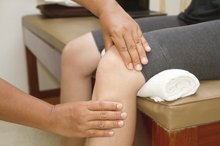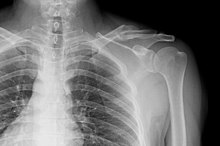How Long Is Rehab After a Bicep Surgery?
The biceps muscle at the front of your upper arm rotates your forearm into a palm-up position and assists with elbow bending and lifting your arm forward. The tendons that attach this muscle to your shoulder and forearm can tear, requiring surgery. Depending on your level of activity, rehab after biceps surgery may last 4 to 6 months.
If you are experiencing serious medical symptoms, seek emergency treatment immediately.
Elbow Protection
Biceps tendon injuries at the elbow typically occur when bending the elbow against very high resistance. According to "Wheeless' Textbook of Orthopaedics," this injury is relatively uncommon and most often affects men between the ages of 50 and 60 years 1. This injury requires surgery to repair the tendon, and rehab begins immediately after surgery. A brace is applied that limits elbow straightening to decrease tension and protect your healing biceps tendon. Your physical therapist will adjust your brace each week to allow more straightening until your brace is fully unlocked, typically by week 8 following surgery.
- Biceps tendon injuries at the elbow typically occur when bending the elbow against very high resistance.
- This injury requires surgery to repair the tendon, and rehab begins immediately after surgery.
Elbow Motion and Strengthening
Recovery & Rehabilitation Time for Shoulder Surgery to Remove Bone Spur
Learn More
Range-of-motion exercises for your fingers and thumb are performed to decrease stiffness after biceps surgery at the elbow. In the first few weeks, your therapist will bend your elbow and rotate your forearm into a palm-up position for you to keep these joints loose without stressing your healing tendon. You will also straighten your elbow halfway and move it into a palm-down position while supporting it with the opposite hand. By week 4, you will likely be bending and straightening your elbow without assistance, within the range allowed by your surgeon. By week 8, you should have full motion in your elbow and forearm in all directions, and your brace will be removed. Strengthening exercises begin and rehab may continue for an additional month or two -- depending on your level of activity -- until you have regained full use of your elbow.
- Range-of-motion exercises for your fingers and thumb are performed to decrease stiffness after biceps surgery at the elbow.
- In the first few weeks, your therapist will bend your elbow and rotate your forearm into a palm-up position for you to keep these joints loose without stressing your healing tendon.
Shoulder Protection
Your biceps can also tear where it attaches to your upper arm bone. The tendon may be damaged from trauma, such as a fall, or overuse of your shoulder. Because other muscles also move your shoulder, surgery is typically not necessary after this injury unless you have damaged other structures in addition to your biceps tendon. Immediately after surgery, your arm will likely be in a sling to protect the repaired tendon. Rehab typically begins a week after this procedure. During this protection phase, your therapist will stretch your shoulder to keep it flexible without stressing the tendon. You will perform range-of-motion exercises for your elbow, wrist and hand to keep these joints moving while your shoulder is protected. You will likely be weaned from your sling by week 3. This protection phase of rehab typically lasts 4 weeks.
- Your biceps can also tear where it attaches to your upper arm bone.
- During this protection phase, your therapist will stretch your shoulder to keep it flexible without stressing the tendon.
Shoulder Motion and Strengthening
How Long Does it Take to Rehab From Meniscus Surgery?
Learn More
Shoulder range-of-motion exercises often begin 4 weeks after surgery. You will use your opposite arm to help move your injured arm until it is strong enough to move on its own. Strengthening exercises may begin once you have regained full motion in your injured shoulder, usually 4 to 6 weeks after your surgery. However, overhead exercises and heavy lifting place more stress on your healing tendon and may be delayed until 10 to 12 weeks after surgery. In total, rehab may last 4 to 6 months, or until you are performing your normal daily activities.
- Shoulder range-of-motion exercises often begin 4 weeks after surgery.
- Strengthening exercises may begin once you have regained full motion in your injured shoulder, usually 4 to 6 weeks after your surgery.
Related Articles
References
- Wheeless' Textbook of Orthopaedics: Distal Biceps Tendon Rupture
- International Journal of Sports Physical Therapy: Rehabilitation of a Surgically Repaired Rupture of the Distal Biceps Tendon in an Active Middle Aged Male: A Case Report
- American Academy of Orthopaedic Surgeons: Biceps Tendon Tear at the Shoulder
- American Academy of Orthopaedic Surgeons. Biceps Tendon Tear at the Elbow. Updated February 2016.
- Guo S. Delayed surgical treatment of distal biceps tendon rupture - a case report. Trauma Mon. 2012;17(3):358–360. doi:10.5812/traumamon.7146
- Sutton KM, Dodds SD, Ahmad CS, Sethi PM. Surgical treatment of distal biceps rupture. J Am Acad Orthop Surg. 2010;18(3):139-48. doi:10.5435/00124635-201003000-00003
Writer Bio
Aubrey Bailey has been writing health-related articles since 2009. Her articles have appeared in ADVANCE for Physical Therapy & Rehab Medicine. She holds a Bachelor of Science in physical therapy and Bachelor of Arts in psychology from the University at Buffalo, as well as a post-professional Doctor of Physical Therapy from Utica College. Dr. Bailey is also a certified hand therapist.








